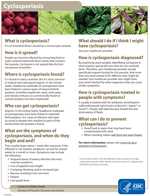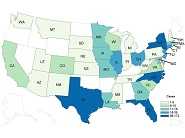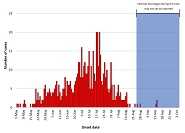Cyclosporiasis Outbreak Investigations — United States, 2017
CDC and federal, state, and local public health partners are investigating an increase in reported cases of Cyclospora infection (cyclosporiasis). Reports of cases tend to increase during summer months in the United States.
Last Updated OCTOBER 6, 2017 10:00 AM EDT
Highlights
More Information
- Cyclospora Information
- Investigating Foodborne Outbreaks
- Advanced Molecular Detection for Cyclospora
- Time to Think About Cyclosporiasis (Medscape)
- CDC: Cyclosporiasis COCA Call/Webinar (for health-care providers)
- CDC: 2017 Health Alert Network (HAN) Advisory (for health-care providers)
- Cyclospora cayetanensis is a single-celled parasite that causes an intestinal infection called cyclosporiasis.
- Advice for consumers about prevention and recognition of cyclosporiasis can be found here.
- As of October 4, 2017 (1:30pm EDT), CDC has been notified of 1,065 laboratory-confirmed cases of cyclosporiasis in persons who became ill in 2017. This number includes persons who reported international travel as well as persons who did not report travel. The reports have come from 40 states.
- At least 597 (56%) of these persons did not report international travel (i.e., likely were infected in the United States) and became ill on or after May 1, 2017 (a date after which cases tend to increase each year). These 597 persons were from the following 36 states: Arizona (1), California (10), Colorado (6), Connecticut (23), Florida (78), Georgia (13), Illinois (17), Indiana (4), Iowa (14), Kansas (2), Louisiana (12), Maryland (12), Massachusetts (14), Michigan (3), Minnesota (13), Mississippi (1), Missouri (13), Montana (2), Nebraska (5), New Hampshire (4), New Jersey (19), New Mexico (1), New York (excluding NYC) (15), New York City (32), North Carolina (49), Ohio (17), Pennsylvania (2), Rhode Island (2), South Carolina (7), South Dakota (4), Tennessee (4), Texas (172), Utah (3), Virginia (9), Washington (2), West Virginia (2), and Wisconsin (10).
Case Count Maps
- At this time, no specific vehicle of interest has been identified, and investigations to identify a potential source (or sources) of infection are ongoing.
- Previous U.S. outbreaks of cyclosporiasis have been linked to various types of imported fresh produce (e.g., basil, cilantro, mesclun lettuce, raspberries, snow peas). Consumers should continue to enjoy the health benefits of eating fresh fruits and vegetables as part of a well-balanced diet.
- Consumers and retailers should always follow safe produce handling recommendations.
- More information about Cyclospora can be found on CDC’s Cyclospora pages.
Epi Curves
Progression of the Outbreak Investigation
September Updates
September 27, 2017
Case Count Update
As of September 27, 2017 (1:00pm EDT), CDC has been notified of 1,054 laboratory-confirmed cases of cyclosporiasis in persons who became ill in 2017. This number includes persons who reported international travel as well as persons who did not report travel. The reports have come from 40 states.
- At least 592 (56%) of these persons did not report international travel (i.e., likely were infected in the United States) and became ill on or after May 1, 2017 (a date after which cases tend to increase each year). These 592 persons were from the following 36 states: Arizona (1), California (10), Colorado (6), Connecticut (23), Florida (78), Georgia (13), Illinois (17), Indiana (4), Iowa (14), Kansas (2), Louisiana (12), Maryland (12), Massachusetts (14), Michigan (3), Minnesota (13), Mississippi (1), Missouri (13), Montana (2), Nebraska (5), New Hampshire (4), New Jersey (19), New Mexico (1), New York (excluding NYC) (15), New York City (32), North Carolina (48), Ohio (17), Pennsylvania (2), Rhode Island (2), South Carolina (7), South Dakota (4), Tennessee (4), Texas (172), Utah (1), Virginia (9), Washington (1), West Virginia (2), and Wisconsin (9).
September 20, 2017
Case Count Update
As of September 20, 2017 (1:00pm EDT), CDC has been notified of 1,031 laboratory-confirmed cases of cyclosporiasis in persons who became ill in 2017. This number includes persons who reported international travel as well as persons who did not report travel. The reports have come from 40 states.
- At least 578 (56%) of these persons did not report international travel (i.e., likely were infected in the United States) and became ill on or after May 1, 2017 (a date after which cases tend to increase each year). These 578 persons were from the following 36 states: Arizona (1), California (10), Colorado (6), Connecticut (23), Florida (75), Georgia (12), Illinois (17), Indiana (4), Iowa (14), Kansas (2), Louisiana (9), Maryland (12), Massachusetts (13), Michigan (3), Minnesota (11), Mississippi (1), Missouri (13), Montana (2), Nebraska (5), New Hampshire (4), New Jersey (19), New Mexico (1), New York (excluding NYC) (15), New York City (32), North Carolina (48), Ohio (17), Pennsylvania (2), Rhode Island (2), South Carolina (7), South Dakota (4), Tennessee (4), Texas (168), Utah (1), Virginia (9), Washington (1), West Virginia (2), and Wisconsin (9).
September 13, 2017
Case Count Update
As of September 13, 2017 (1:30pm EDT), CDC has been notified of 988 laboratory-confirmed cases of cyclosporiasis in persons who became ill in 2017. This number includes persons who reported international travel as well as persons who did not report travel. The reports have come from 40 states.
- At least 553 (56%) of these persons did not report international travel (i.e., likely were infected in the United States) and became ill on or after May 1, 2017 (a date after which cases tend to increase each year). These 553 persons were from the following 36 states: Arizona (1), California (10), Colorado (6), Connecticut (23), Florida (68), Georgia (10), Illinois (17), Indiana (4), Iowa (14), Kansas (2), Louisiana (7), Maryland (12), Massachusetts (13), Michigan (3), Minnesota (11), Mississippi (1), Missouri (13), Montana (2), Nebraska (5), New Hampshire (4), New Jersey (19), New Mexico (1), New York (excluding NYC) (15), New York City (30), North Carolina (45), Ohio (16), Pennsylvania (2), Rhode Island (2), South Carolina (7), South Dakota (4), Tennessee (3), Texas (163), Utah (1), Virginia (7), Washington (1), West Virginia (2), and Wisconsin (9).
September 6, 2017
Case Count Update
As of September 6, 2017 (1pm EDT), CDC has been notified of 957 laboratory-confirmed cases of cyclosporiasis in persons who became ill in 2017. This number includes persons who reported international travel as well as persons who did not report travel. The reports have come from 40 states.
- At least 533 (56%) of these persons did not report international travel (i.e., likely were infected in the United States) and became ill on or after May 1, 2017 (a date after which cases tend to increase each year). These 533 persons were from the following 36 states: Arizona (1), California (10), Colorado (6), Connecticut (23), Florida (67), Georgia (9), Illinois (17), Indiana (4), Iowa (10), Kansas (2), Louisiana (7), Maryland (12), Massachusetts (13), Michigan (3), Minnesota (11), Mississippi (1), Missouri (13), Montana (2), Nebraska (5), New Hampshire (3), New Jersey (16), New Mexico (1), New York (excluding NYC) (14), New York City (30), North Carolina (44), Ohio (15), Pennsylvania (2), Rhode Island (2), South Carolina (7), South Dakota (4), Tennessee (3), Texas (159), Utah (1), Virginia (6), Washington (1), West Virginia (2), and Wisconsin (7).
August Updates
August 30, 2017
Case Count Update
As of August 30, 2017 (3pm EDT), CDC has been notified of 930 laboratory-confirmed cases of cyclosporiasis in persons who became ill in 2017. This number includes persons who reported international travel as well as persons who did not report travel. The reports have come from 40 states.
- At least 514 (55%) of these persons did not report international travel (i.e., likely were infected in the United States) and became ill on or after May 1, 2017 (a date after which cases tend to increase each year). These 514 persons were from the following 36 states:
Arizona (1), California (10), Colorado (6), Connecticut (22), Florida (65), Georgia (7), Illinois (17), Indiana (3), Iowa (8), Kansas (2), Louisiana (7), Maryland (12), Massachusetts (13), Michigan (3), Minnesota (11), Mississippi (1), Missouri (13), Montana (2), Nebraska (5), New Hampshire (3), New Jersey (16), New Mexico (1), New York (excluding NYC) (13), New York City (30), North Carolina (39), Ohio (14), Pennsylvania (2), Rhode Island (2), South Carolina (7), South Dakota (4), Tennessee (3), Texas (155), Utah (1), Virginia (6), Washington (1), West Virginia (2), and Wisconsin (7).
August 25, 2017
Case Count Update
As of August 25, 2017 (9am EDT), CDC has been notified of 882 laboratory-confirmed cases of cyclosporiasis in persons who became ill in 2017. This number includes persons who reported international travel as well as persons who did not report travel. The reports have come from 39 states.
- At least 478 (54%) of these persons did not report international travel (i.e., likely were infected in the United States) and became ill on or after May 1, 2017 (a date after which cases tend to increase each year). These 478 persons were from the following 34 states: Arizona (1), California (10), Colorado (6), Connecticut (20), Florida (61), Georgia (7), Illinois (14), Indiana (3), Iowa (8), Kansas (2), Louisiana (7), Maryland (3), Massachusetts (13), Michigan (3), Minnesota (11), Missouri (13), Montana (2), Nebraska (5), New Hampshire (3), New Jersey (15), New Mexico (1), New York (excluding NYC) (13), New York City (29), North Carolina (36), Ohio (12), Pennsylvania (1), Rhode Island (2), South Carolina (5), South Dakota (4), Tennessee (2), Texas (151), Utah (1), Virginia (5), West Virginia (2), and Wisconsin (7).
August 18, 2017
Case Count Update
As of August 16, 2017 (3pm EDT), CDC has been notified of 712 laboratory-confirmed cases of cyclosporiasis in persons who became ill in 2017. This number includes persons who reported international travel as well as persons who did not report travel. The reports have come from 36 states.
- At least 347 (49%) of these persons did not report international travel (i.e., likely were infected in the United States) and became ill on or after May 1, 2017 (a date after which cases tend to increase each year). These 347 persons were from the following 31 states: Arizona (1), California (5), Colorado (6), Connecticut (18), Florida (36), Georgia (4), Illinois (11), Indiana (3), Iowa (8), Kansas (2), Louisiana (3), Maryland (3), Massachusetts (11), Michigan (1), Minnesota (10), Missouri (8), Montana (2), Nebraska (5), New Hampshire (2), New Jersey (10), New Mexico (1), New York (excluding NYC) (12), New York City (27), North Carolina (19), Ohio (6), Pennsylvania (1), Rhode Island (2), South Dakota (4), Texas (116), Utah (1), Virginia (2), and Wisconsin (7).
INITIAL ANNOUNCEMENT
August 11, 2017
As of August 8, 2017 (2pm EDT), CDC has been notified of 570 laboratory-confirmed cases of cyclosporiasis in persons who became ill in 2017. This number includes persons who reported international travel as well as persons who did not report travel. The reports have come from 35 states.
- At least 251 (44%) of these persons did not report international travel and were likely infected in the United States, and became ill on or after May 1, 2017 (a date after which cases tend to increase each year).
- Page last reviewed: October 6, 2017
- Page last updated: October 6, 2017
- Content source:



 ShareCompartir
ShareCompartir

